#Physical benefits of Vajrasana
Text
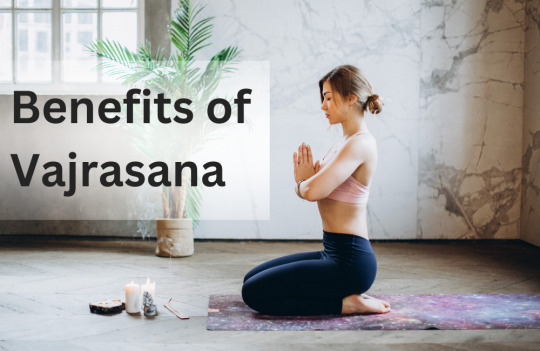
Benefits of Vajrasana: A Guide to Improved Health
Vajrasana, also known as the Thunderbolt Pose, is a yoga asana known for its numerous health benefits. This simple yet effective sitting posture is renowned for its positive impact on physical, mental, and digestive health. Exploring the advantages of practicing Vajrasana can lead to improved overall wellness and a better understanding of the transformative power of this yoga posture.
Physical Benefits of Vajrasana:
Improved Digestion: Practicing Vajrasana after meals aids digestion by increasing blood flow to the pelvic region and stimulating the digestive organs, thereby reducing indigestion and bloating.
Strengthened Pelvic Muscles: Regular practice helps strengthen the muscles of the pelvic floor, promoting better bladder control and supporting reproductive health.
Relief from Lower Body Ailments: Vajrasana helps alleviate knee pain, strengthens leg muscles, and can be beneficial for those suffering from sciatica or varicose veins.
Enhanced Posture: Regular practice of Thunderbolt Pose helps improve posture and spine alignment, reducing strain on the back and shoulders.
Mental Health Benefits of Vajrasana:
Stress Reduction: The calming effect of practicing Vajrasana aids in reducing stress and anxiety, promoting mental relaxation.
Improved Focus and Concentration: Regular practice enhances focus, concentration, and mental clarity, aiding in better cognitive function.
Balanced Energy Flow: This pose helps balance the flow of energy in the body, promoting a sense of equilibrium and harmony.
Digestive Benefits of Vajrasana:
Stimulated Digestive Fire: Vajrasana activates the Agni (digestive fire), improving metabolism and ensuring better absorption of nutrients.
Relief from Gas and Acidity: Regular practice aids in preventing and alleviating gas, acidity, and other digestive discomforts by facilitating proper digestion.
How to Practice Vajrasana:
Start by Kneeling: Kneel on the floor with your knees close together and the tops of your feet flat on the mat.
Sit Back on Your Heels: Slowly lower your buttocks down, sitting on your heels while keeping your back straight.
Place Hands on Thighs: Rest your hands on your thighs or let them rest gently on your knees, palms facing downward.
Hold the Pose: Breathe deeply and comfortably in this seated position, maintaining a straight spine and relaxed shoulders.
Duration: Begin with holding the pose for a few minutes and gradually extend the duration as per your comfort level.
Precautions:
Individuals with knee injuries or recent surgeries should avoid or modify this pose as needed.
Pregnant women should practice Vajrasana under guidance and avoid excessive pressure on the abdomen.
In conclusion, incorporating Vajrasana into your daily routine can offer a multitude of health benefits, promoting physical well-being, mental calmness, and digestive health. Remember to practice yoga under the guidance of a qualified instructor, especially if you're new to these postures, ensuring safe and effective practice. Embrace the transformative power of Vajrasana and reap its holistic benefits for improved health and vitality.
For more information visit - https://maxinhealth.com/
#Vajrasana benefits#Thunderbolt Pose advantages#Yoga for health#Physical benefits of Vajrasana#Mental health benefits of Thunderbolt Pose#Digestive benefits of yoga posture
0 notes
Text
Bhadrasana, often known as the Gracious Pose, is a yoga asana that holds a special place in the practice of spiritual seekers. It not only aids in physical flexibility but also stimulates the Mooladhara Chakra, making it an excellent choice for meditation. This asana shares many benefits with Vajrasana and is particularly suitable for those on a spiritual journey.
Read more about this yoga pose in our latest blog:
https://adiyogaashram.com/blog/yoga/bhadrasana-steps-and-benefits/
2 notes
·
View notes
Text
Why Vajrasana?
Vajrasana is a very simple sitting posture and a novice can start its practice with this asana as it is comparatively easy to perform than other asanas and helps to strengthen the knee, ankles, hips, spine and digestive system. Further, it also helps to relax the body muscles.
What is Vajrasana?
The word Vajrasana consists of two Sanskrit words, Vajra and Asana. Vajra means Diamond-like or Thunderbolt and Asana mean “posture”. According to Hindu Mythology, Vajra is said to be the most powerful weapon of God “Indra” and it is made of bones. Like ways, regular practise of this posture, makes a Yogi very robust and steady, both physically and mentally. Therefore, this posture is called Vajrasana.
Further, there is another school of thought that this posture is called Vajrasana as helps to activate the Vajra Nadi in our body. Vajra Nadi is located within the spine. It begins from the Muladhara chakra (base chakra) and goes to mind. It regulates the energy in the body.
This posture is also called as Diamond pose, Adamant Pose, Thunderbolt pose, Pelvic pose and Keeling pose.
Know more about yoga asanas on the official blog of fitness and more gym.
0 notes
Text
Air pollution: Deep breathing exercises to keep lungs healthy
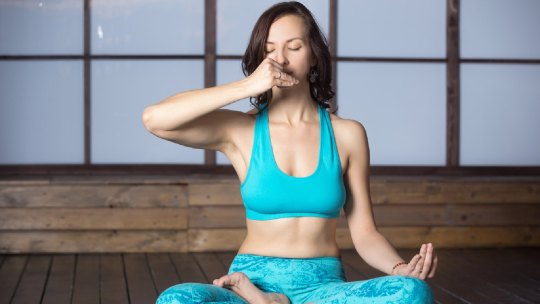
The level of air pollution always increases due to the transition from summer to winter and the beginning of festivals. People who suffer from asthma and other respiratory conditions are particularly vulnerable to the burden of toxic air. Breathing in such circumstances is considered dangerous for the body. Studies even say it can be equivalent to smoking 20 cigarettes every day! Yoga can help prevent toxins from entering your body, and you can also do deep breathing exercises to increase lung capacity.
When outdoor air quality is poor, practice breathing exercises to prevent pollutants from damaging your respiratory system.

Practice deep breathing exercises to avoid lung problems. Image Courtesy: Adobe Stock
Deep breathing exercises to beat air pollution
Here are three simple breathing exercises to combat the effects of air pollution, suggested by yoga expert Nisha Dhawan.
1. Anulom Vilom Pranayam
Nadi Shodhana Pranayam is a breathing technique that helps in clearing blocked channels. This technique is also known as Anulom-Vilom Pranayam. Regular practice of at least 10 minutes per day will help clear blockages and is designed to purify the nadis or energy channels.
2. Kapalbhati
Kapalbhati is the top choice of every yoga practitioner. It helps in detoxifying the entire system. For people suffering from shortness of breath, this breathing technique can help flush out toxins from the lungs and brain. Kapalabhati increases oxygen flow and improves digestion besides clearing the respiratory system.
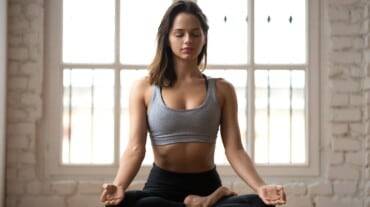
Do Kapalbhati to strengthen your lungs! Image Courtesy: Shutterstock
3. Bhastrika
This breathing exercise – often called the breath of fire – aids detoxification and removes pollutants from the body. This technique helps in keeping the stomach free from toxins and boosts our immunity.
The best way to practice Bhastrika is to sit in Vajrasana or Sukhasana, the classic cross-legged yoga position. Now make fists and bend your arms keeping them near your shoulders. While inhaling, raise your arms straight and open your fists. Now exhale forcefully as you bring your arms back to your shoulders and close your first arms. Continue this for at least 20 repetitions. Rest to end the session.
Yoga experts recommend doing these three breathing exercises regularly in the morning or afternoon, which can help reduce stress levels and flush out toxins from the body.
What are the benefits of deep breathing exercises?
1. Detoxification
Breathing exercises aid detoxification and give you energy. More air can flow in and out of your lungs allowing you to be more physically active.
2. Increase oxygen level
Breathing exercises can help get rid of stale air accumulated in the lungs, increase oxygen levels, and get the diaphragm back to its function. When your lungs are healthy, breathing becomes natural and easy.
3. Improves lung capacity
Breathing exercises can potentially help maintain or increase lung capacity in people who have no underlying lung problems.
4. To lead to relaxation
Deep breathing exercises can also stimulate the parasympathetic nervous system, which promotes relaxation and aids digestion.
Can everyone do deep breathing exercises?
Breathing exercises can be beneficial for all age groups, including children, adults and the elderly. People who have breathing problems or health problems, such as heart arrhythmia, slow heart rate, high blood pressure, angina or chest pain and heart disease – they should be careful and seek guidance before starting any breathing exercises. . Children below 5 years of age, unlike adults, should not engage in complex breathing techniques like Kapalbhati or hold their breath while doing pranayama for long periods of time. All breathing exercises should be done under the guidance of a professional.
Yoga expert Nisha Dhawan says it's important to remember that some breathing exercises may not be suitable for everyone, especially people with specific medical problems. Please consult your doctor before starting any new breathing exercises.
Read the full article
#Benefitsofdeepbreathingexercises#breathingexercisesforhealthylungs#deepbreathingexercises#Exercisetoincreaselungcapacity#healthshots#Howtobeatairpollution
0 notes
Text
8 Yoga Asanas That Can Help With Hair Growth
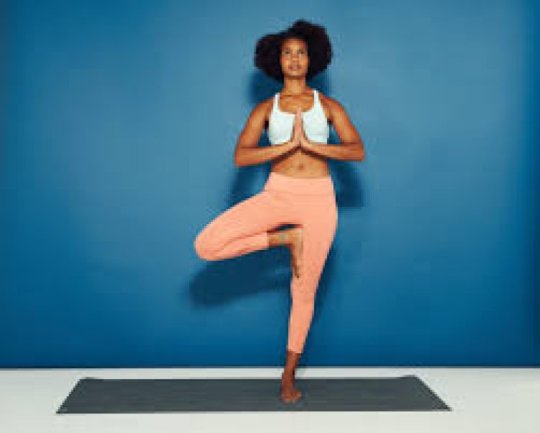
By Thealthiest WebDesk: Yoga offers numerous holistic health benefits. This ancient form of physical fitness, which is also a way of life, has been known to not only protect inner and mental health but also treat skin and hair conditions. There are a number of yoga asanas that can aid in hair growth if you're sick of your short bob and want lengthier locks. In truth, yoga for hair growth and improved health has been gaining popularity around the globe due to its impressive results. Here are some yoga asanas for hair growth, which also reduce hair loss and improve their overall health.
Best eight Yoga Asanas for Hair Growth
1. Kapalabhati
2. Adho Mukha Svanasana
3. Sarvangasana
4. Balasana
5. Sirsasana
6. Vajrasana
7. Uttanasana
8. Matsyasana
FAQs:
1. Kapalabhati
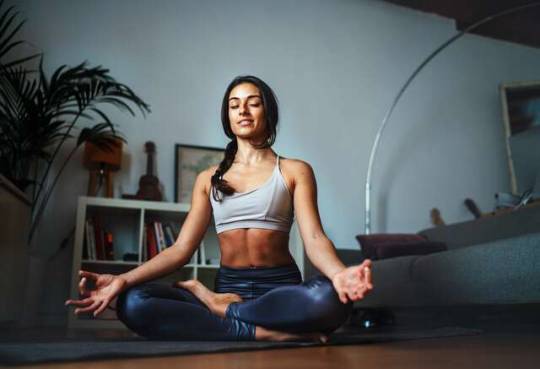
Kapala, which means "skull," and Bhati, which means "light," are the origins of Kapalhbhati. It is a mind-body activity that refreshes, purifies, and energizes. This breathing exercise assists in removing impurities from the kapal, which refers to the entire head or face region, thereby enhancing oxygen supply and decreasing free radicals, thereby promoting hair growth. Additionally, it reduces tension and anxiety, which are also contributors to hair loss.
How To: Cross your legs while maintaining an upright back, neck, and head position. Place your hands on your knees with your palms facing upward and relax every muscle in your body. Inhale deeply and then exhale all the oxygen while contracting abdominal muscles. Perform this for a few minutes.
Pro Tip: It is advised to practice Kapalabhati early in the morning on an empty stomach.
2. Adho Mukha Svanasana
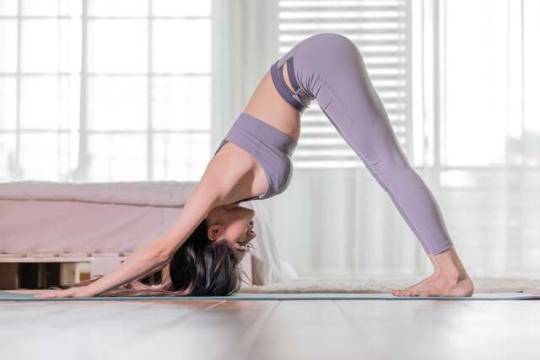
Adho Mukha Svanasana, also known as the downward facing dog pose, is one of the twelve asanas performed during Surya Namaskar. It is a transitional resting position that stimulates blood circulation. This promotes hair growth by increasing the amount of oxygen reaching the epidermis. This asana also provides a variety of additional physical benefits. For instance, it helps to calm the mind, refresh and energize the body.
How To: Stand with your feet hip-width apart and your palms extended toward the ground. Take a few strides in reverse and stretch your wrists and legs. With your ears contacting your limbs, lie facedown. Maintain the position for 30 to 45 seconds. This is one of the most effective yoga asanas for preventing hair loss and increasing blood flow to the cranium.
Pro Tip: Avoid doing this asana if you suffer from any of the following problems:
Carpal tunnel syndrome, high blood pressure, retinal detachment, a dislocated shoulder, weak eye capillaries, diarrhea.
3. Sarvangasana

The shoulder stand, or Sarvangasana*, is a full-body exercise that targets multiple muscle groups. It improves both your balance and posture. In addition, this asana improves your head's blood circulation. The pose has a long-lasting affect on the scalp and is especially advantageous for dry and thin hair.*
How To: Make a right angle with your legs while lying on your back against a wall. Then, using your hands for support, you elevate your hips off the ground and balance your entire body on your shoulders.
Pro Tip: If you suffer from slip disc, heart problems or high blood pressure*, do consult your doctor before practicing this pose.*
Continue reading on thealthiest...
0 notes
Text
53 Daily Yoga exercises

Yoga is a physical, mental, and spiritual discipline that originated in ancient India. It involves a series of poses, or asanas, that are designed to improve flexibility, strength, and balance. Yoga also includes deep breathing techniques and meditation, which can help to reduce stress and improve overall well-being.
There are many different styles of yoga, including Hatha, Vinyasa, and Bikram. Hatha yoga is a slower-paced style that focuses on holding poses for longer periods of time, while Vinyasa yoga involves a flow of continuous movement. Bikram yoga is practiced in a heated room and consists of a set series of 26 poses.
The physical benefits of yoga include increased flexibility, strength, and balance. It can also help to improve posture and reduce the risk of injuries. In addition to the physical benefits, yoga can also have mental and spiritual benefits, such as reducing stress and anxiety, improving concentration, and fostering a sense of inner peace.
Yoga is suitable for people of all ages and fitness levels and can be modified to suit individual needs and abilities. It is generally considered to be a safe form of exercise, but it is always a good idea to consult with a healthcare provider before starting any new exercise program.
53 Daily Yoga exercises :
Sun salutation (Surya Namaskar)
Downward facing dog (Adho Mukha Svanasana)
Warrior pose (Virabhadrasana)
Triangle pose (Trikonasana)
Chair pose (Utkatasana)
Tree pose (Vrikshasana)
Cobra pose (Bhujangasana)
Child's pose (Balasana)
Cat-cow pose (Marjaryasana-Bitilasana)
Upward facing dog (Urdhva Mukha Svanasana)
Half pigeon pose (Ardha Kapotasana)
Plank pose (Phalakasana)
Camel pose (Ustrasana)
Seated forward bend (Paschimottanasana)
Bridge pose (Setu Bandha Sarvangasana)
Half lotus pose (Ardha Padmasana)
Corpse pose (Savasana)
King dancer pose (Natarajasana)
Crane pose (Bakasana)
Camel pose (Ustrasana)
Extended triangle pose (Utthita Trikonasana)
Fish pose (Matsyasana)
Bow pose (Dhanurasana)
Half lord of the fishes pose (Ardha Matsyendrasana)
One-legged downward facing dog (Eka Pada Adho Mukha Svanasana)
Bound angle pose (Baddha Konasana)
Lion pose (Simhasana)
Leg lift (Utthita Padangusthasana)
Side plank (Vasisthasana)
Fire log pose (Agnistambhasana)
Wheel pose (Urdhva Dhanurasana)
Pigeon pose (Kapotasana)
Half bound lotus pose (Ardha Baddha Padmasana)
Low plank (Chaturanga Dandasana)
Warrior 3 (Virabhadrasana III)
Headstand (Sirsasana)
Cow face pose (Gomukhasana)
Shoulder stand (Sarvangasana)
Hero pose (Virasana)
Wide-legged forward bend (Prasarita Padottanasana)
Happy baby pose (Ananda Balasana)
Thunderbolt pose (Vajrasana)
King pigeon pose (Eka Pada Rajakapotasana)
Seated twist (Ardha Matsyendrasana)
King dancer (Natarajasana)
Seated forward bend (Paschimottanasana)
Reclining bound angle pose (Supta Baddha Konasana)
Seated spinal twist (Ardha Matsyendrasana)
Reclining hero pose (Supta Virasana)
Puppy pose (Uttana Shishosana)
Seated mountain pose (Padmasana)
Reclining hand to foot pose (Supta Padangusthasana)
Reclining lord of the fishes pose (Supta Matsyendrasana)
Here are some tips for incorporating exercise into your daily routine:
- Set specific times for your workouts and try to stick to them. This can help you make exercise a regular part of your day.
- Make sure to vary your workouts. Doing the same thing every day can get boring and may increase your risk of overuse injuries.
- Choose activities that you enjoy. If you hate running, don't force yourself to go for a run every day. There are plenty of other options, such as cycling, swimming, or taking a dance class.
- Gradually increase the intensity and duration of your workouts over time. This will help you avoid burnout and keep your workouts challenging.
- Find a workout buddy or consider joining a group fitness class. This can help motivate you to stick with your exercise routine.
- Don't be too hard on yourself if you miss a workout or don't have time for a long workout. Every little bit of exercise counts and it's okay to have rest days.
Remember to always listen to your body and modify the poses as needed. It's important to warm up before starting your yoga practice and to cool down afterwards. It's also important to practice with proper alignment to avoid injury. It may be helpful to work with a certified yoga instructor, especially if you are new to yoga.
Keep Reading :
The Best Way to Wash Your Face
Physical fitness, importance, research, precaution to start
Meditation practice to fits into your lifestyle
Read the full article
0 notes
Text
Chair yoga sequence for seniors

#Chair yoga sequence for seniors trial
#Chair yoga sequence for seniors trial
Functional improvements in Parkinson's disease following a randomized trial of yoga. Use pillows or bolsters for support under your torso or forehead if you have a tight lower back or stiff hips, knees, or ankles. Hold this position while breathing for 5 minutes or as long as you are comfortable. Van Puymbroeck M, Walter AA, Hawkins BL, et al. Place your hands, palms up, next to your feet. How to do it: The position is basically sitting down on your legs with your heels touching your bottom. One year of yoga training alters ghrelin axis in centrally obese adults with metabolic syndrome. Diamond thunderbolt (Vajrasana) Benefits: This pose helps regulate blood circulation in your pelvic area and aids in digestion. The effects of chair yoga with spiritual intervention on the functional status of older adults. An unconditional belief that you are perfectand whole while ever-changing and growing.She completed her 200 hour trainingwith Yogaworks senior teachers Alicia Cheung &Oliver Reinsch in Bali, Indonesia and went on to study prenatal and postpartum yoga with doula and French-American woman’s advocate, Alexandra Rossi in San Francisco, CA. Cycling has numerious wonderful health benefits for older adults, including slowing the aging process. 8 Surprisingly Wonderful Benefits of Cycling for Seniors. Chair Yoga: a Complete At Home Video Practice. Effects of chair yoga therapy on physical fitness in patients with psychiatric disorders: A 12-week single-blind randomized controlled trial. Chair yoga for seniors: a 30 minute routine Warm up poses for heat and circulation (30 seconds in video) Standing poses for balance and strength (9 min 50 sec. This is a complete 17-minute beginner friendly yoga sequence suitable for all ages you can do on your chair. National survey of yoga practitioners: Mental and physical health benefits. A pilot randomized controlled trial of the effects of chair yoga on pain and physical function among community-dwelling older adults with lower extremity osteoarthritis. Park J, McCaffrey R, Newman D, Liehr P, Ouslander JG.

0 notes
Text
Yogasans Effective in Hair problems
Yoga is rich in holistic health benefits. A way of life, this ancient fitness not only protects your inner and mental health, but is also known to heal skin and hair problems. If you're tired of your short bob and want your hair to grow longer, there are some yoga asanas that can actually help with hair growth. Here are some yoga asanas that not only promote hair growth but also help reduce hair loss and improve health.
Kapalabhati
Adho Mukha Svanasana
Sarvangasana
Balasana
Sirsasana
Vajrasana
Uttanasana
Matsyasana
1. Kapalabhati
Kapalhbhati comes from two Sanskrit words, kapala meaning 'skull' and bhati meaning 'light'. It is a rejuvenating, cleansing and energizing activity for the mind and body.

This breathing exercise removes toxins from Kapar, an area of the head or entire face, increases oxygenation, reduces free radicals and allows for hair growth. help alleviate.
HOW TO DO:
Sit with your legs crossed, keeping your back, neck and head straight. Place your hands on your knees, palms up, and relax all muscles. Take a deep breath, then exhale all the air and contract your abs. Do this for a few minutes.
Pro Tip
: It is recommended to practice kapalabhati early in the morning on an empty stomach.
2. Adho Mukha Svanasana
Adho Mukha Svanasana (better known as Downward Facing Pose) is one of the 12 poses that Surya practices in his Namaskar. It is a transitional resting position that increases blood flow. This allows more oxygen to reach the scalp and promotes hair growth. This asana has many other physical benefits as well. For example, it helps calm the mind, rejuvenate and energize the body.

Method:
Stand with your feet hip-width apart and grab the floor with both hands. Take a few steps back and stretch your arms and legs. Lie on your stomach with your ears on your arm
Hold the pose for 30-45 seconds. This is one of the best yoga asanas to prevent hair loss and increase blood circulation in the scalp.
PRO TIP:
Avoid this asana if you have any of the following:
Carpal tunnel syndrome, high blood pressure, retinal detachment, shoulder dislocation, weakened eye capillaries, diarrhea.
3. Sarvangasana
Sarvangasana, or shoulderstand, is a full-body exercise that works different muscle groups. Helps improve balance and posture. Apart from that, this asana improves blood flow to the head. Daily practice of the pose has lasting effects on the head and is especially beneficial for dry, fine hair.
Method
: Lie on your back against a wall with your legs at a 90-degree angle to her. Then lift your buttocks off the floor and use your hands to prop them up and balance your entire body on your shoulders.
Pro Tip:
If you have a herniated disc, heart disease, or high blood pressure, consult your doctor before doing this pose.
4. Balasana
Before you get the idea, balasana literally means child's pose and does not refer to hair. However, it does fight stress and digestive issues, the two biggest factors that cause hair loss. Balasana is commonly recommended to relieve stomach problems and is known to help with anxiety Practicing this pose daily has positive effects on digestion and mental health and can significantly reduce the risk of hair loss.
Procedure:

Sit on mat with knees bent and feet at hips.
Inhale, reach your hands up, and as you exhale, bend your core until your forehead and palms are on the floor. If you can get your elbows on the ground, that's a bonus. Concentrate on your breathing and from 30 seconds she holds the pose for 1 minute.
PRO TIP:
Avoid this asana if you have problems with diarrhea, knee injuries, severe neck or back pain, high blood pressure, dizziness, or herniated discs.
5. Sirsasana
Sirsasana Yoga Asana for Hair Growth
Sirsasana, also known as headstand, improves blood flow to the scalp and reduces hair loss, thinning hair and baldness. This asana helps new hair growth and prevents hair graying. Promotes hair growth by helping dormant hair follicles reach their maximum growth potential.
Instructions
: Kneel and place fingers crossed behind head. Bend down and touch the floor with your forehead. Support the top of your head with your interlaced hands and slowly raise your legs to stand upside down perpendicular to the floor. Keep your feet together and your arms straight. Once your body stabilizes in this pose, hold your balance for a few seconds.
Pro Tip:
Perfecting this pose takes a lot of practice. If you're a beginner, try getting help from another person or leaning against a wall.
6. Vajrasana
Vajrasana, or Thunder Pose, is simple yet very powerful. It squarely addresses stomach-related issues that you may or may not think play a big role when it comes to hair loss. may be connected. Vajrasana can help alleviate and heal many of these problems and can also help improve the digestion of food. This helps with hair growth as the nutrients are better absorbed by the body when digestion is at its peak. Of course, a healthy diet is essential for long, thick and healthy hair.
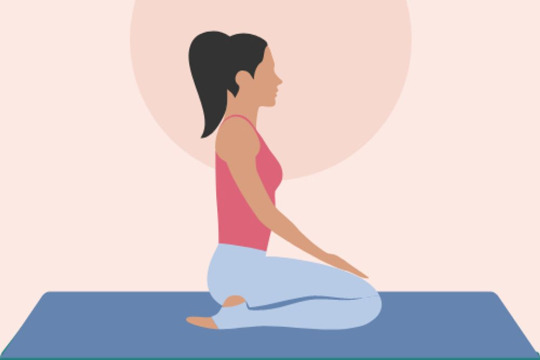
Hold your hands on your thighs in a relaxed position, palms down, keeping your head and eyes straight. Hold this position for at least 30 seconds while taking deep breaths. Relax and stretch when finished.
Pro Tip: Try sitting in Vajrasana every day to tone your stomach.
7. Uttanasana
Uttanasana Yoga Asana for Hair Growth
Uttanasana AKA Camel Pose is an effective yoga asana that takes some time to master. This yoga pose stretches and relaxes your muscles, increasing oxygen levels and blood flow to your head. This makes the follicles stronger and the hair longer.
Not only does it improve the quality and texture of your hair, it also makes it flawless and shiny.
Instructions
: Stand up straight with your feet together. Raise your arms and take a deep breath. Without exhaling, straighten your arms and lean forward. Touch the mat when it feels comfortable. Move and hug your knees and keep your head down all the way. Hold this pose for 15-30 seconds. Mastering this yoga asana may require some practice. Remember to exhale when you stand up.
PRO TIP
: Avoid practicing this asana if you have back, knee, or ankle injuries.
8. Matsyasana
Matsyasana Yoga Asanas for Hair Growth
Commonly known as fish pose, this pose is one of the most effective and popular asanas for creating strong, long and healthy hair. It is fairly easy to practice and like the other poses above, it can be done quickly at home and requires no equipment.This yoga asana can alleviate most hair problems with daily practice. Known.
Method:
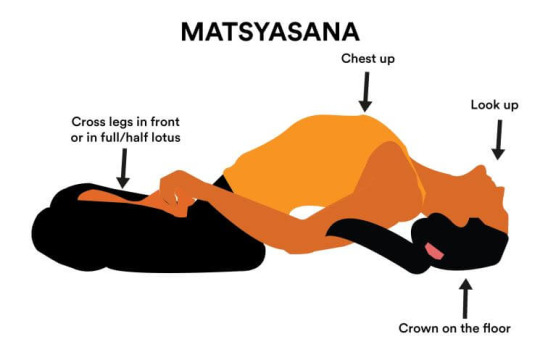
In this asana, lie on your back and bend your knees inward as if you were sitting cross-legged. Place your hands on your hips, palms down
#yogasans#hair problem#yogasans for hair loss#hair problems#hair treatment#sarvangasana#Kapalabhati Adho Mukha Svanasana Sarvangasana Balasana Sirsasana Vajrasana Uttanasana Matsyasana#kapalbhati#adho kukha sarvasana#balasan#sirsasana#vajrasana#uttanasana#matsyasana
0 notes
Text
Yoga For Physical and Mental Wellness

The meaning of Yoga is to connect the Soul with God. Moksha (Salvation), freedom from all types of pain by living a balanced life is the ultimate goal of Yoga. Doing away with mundane and trivial desires arising in the mind is Yoga.
Yoga is a technique through which man exercised control over his physical and mental being, to attain hitherto unachieved states of bliss and to be able to conjecture on God or The Supreme Soul, the Parmatma, and to dwell upon the creation and existence of this world. Yoga offers a path to final Salvation as well as a more temporal kind, temporal in terms of relieving unhappiness, the kind that certainly results from poor health.
The practice or process of Yoga are very beneficial for the maintenance of health. It helps to maintain both physical and mental health, which cannot be done by either taking pills or drinking potions. Yoga helps one overcome mental depression as well as attain equilibrium between body and soul. It increases the capacity to work and benefits the brain by increasing retention power and memory.
Yoga is known as Astanga or eight-faceted Yoga and these eight facets are Yama, Niyama, Asana, Pranayama, Pratyahara, Dharana, Dhyana, and Samadhi.
Yama: It stands for Ahimsa, benevolence to all living beings, respect and tolerance and objectivity in all feeling, doing and observing.
Satya (Truth): One must always speak and think truthfully.
Asteya (Abstaining from Stealing): One who overcomes such act is showered with precious stones.
Brahmacharya (Celibacy): It is when the mind fuses with the Parabrahma or the highest level of consciousness. Brahmacharya would include doing away with: thinking about sexual partners, singing about attractions, about ladies, meeting, interacting with other potential partners, other ladies, coitus and voyeurism, viewing entertainment with titillating content, reading books or discussing or viewing material with pornographic content, and Kriya Nispathi.
Rutu Kala: One must not indulge physically with any other than one's lawfully wedded wife or husband and that too only during Rutu Kala, the period which starts on the fourth day after menstruation and ends on the sixteenth.
Aparigraha: Although enjoyable, many things we do and are addicted to, such as some of the foods that we eat, are not good for us and must be given up.
Niyama: It encompasses the five concepts of Cleanliness, Contentment, Penance, Swadhyaya and Ishwari Pranidhana.
Santoshadanuttama Sukha Labha; to be truly happy and contented is a state of mind.
Vidhinoktera Margena Kricchra Chandra Yanadibhi:|
Sareera Soshanam Prahu Stapa Sasta Pa Uttanam||
This advocates leading an austere life.
Karyendrisiddhirasuddhi Kshaya Staasa:|
Practice the Vedas and Mantras of which the Gayatri Mantra is the root, strictly in accordance to the procedure prescribed in the Shastras.
Kamatos Kamatospi Yatkaromisubhasubhi|
Tatsarvam Twayivinyasya Twatparata Yuktaha karomyoham||
One should devote one's soul to God and dedicate one's work to Him regardless of whether one's work brings any material gains.
Samadhi Siddhirswareeswara Pranidhanath|
By practicing Yama and Niyama and the Asanas of Yoga, one is able to gain control of one's body, mind and soul, and thereby gain control over disease.
When the focus of practice is on the Antaratma, the inner spirit of the soul, it is called Hathayoga, and when this focus is on the Atma or one's own mentality, it is called Rajayoga.
To sum up, the Yoga Asanas help to condition the body, the mind and the soul so that one can overcome impervious to disease, but before Asanas may be practice, a suitable state of mental readiness must be achieved.
The practice of Yoga involves the imposition of considerable self-discipline in one's diet and in the activities one pursues. A Satvic diet is advocated for those who wish to take up Yoga as a practice. The practitioner's diet must consist of foods that are healthy and provide strength and well-being, foods of the quality comparable to those that are offered to Gods.
Yoga may be practiced at various levels, and so, it is a beneficial activity. The place for practicing Yogasanas must be clean and airy but not windy. It should not be performed in an unclean or offensive smell area and also never on the roof or in a basement.
Before the conclusion of the session, the practitioner should have work up a light sweat. At this stage, he or she should rub down the perspiration on the body itself before bathing. At the conclusion of a session of Yogasanas, the body should not be exposed to breeze for at least an hour, otherwise it will sap strength. Perspiration should be rubbed down on the body itself, before a bath in tepid or hot water. One should not be on a fast or without nourishment when practicing Yoga. Yoga practitioners should respect and obey God, their elders, the Gurus and parents.
The practice of Yoga is beneficial for all ages and genders, from the time when a child is about eight years old. Practice of Yoga is not advised for pregnant women. Regular practice of Yogasanas rejuvenates the body. It gives relief to ailments of both the body and the mind.
Asanas in Yoga and their Benefits:
The Sun Salutation (Surya Namaskara):
A proper starting point for the practice of Yoga is the Surya Namaskara or a salutation to the sun. The Sun Salutation provides happiness to the body, the mind and the senses. It is good for the heart. The regular performer will live long, be hale and hearty, with a strong and a sturdy body and keen intellect.
Kurmasana:
This exercise will reduce the formation of phlegm in the chest and throat. It is also beneficial for the heart, lungs and the cardiovascular system, besides strengthening the chest and the back.
Padmasana:
It improves the consciousness and the intellect, and brings about mental stability. On the physical level, it will reduce the fat in the thighs.
Sarvangasana:
This exercise stimulates the thyroid glands and the genitalia of both males and females. It is also useful in conditions of haemorrhoids, hernias and menstrual disorder. But it is not to be practiced by people suffering from cervical spondylitis.
Matsyasana:
It provides benefits to sufferers of bronchial asthma and Diabetes Mellitus.
Bhujangasana:
This exercise is good for developing the ligaments of the back and beneficial for the sufferers of backache. It also benefits those with cough and respiratory disease, besides ridding the body of fat or adipose tissue around the abdomen.
Dhanurasana:
This exercise is meant for the relief of stomach disorders and to improve digestion.
Shirsasana:
This exercise, which culminates in a headstand, enhances blood supply to the brain, besides providing a high level of conditioning to the body. It stimulates the thyroid and pituitary glands and is good for relieving a condition known as orchitis, as well as dysfunction connected with virility. It enhances blood flow to the brain and so benefits all brain functions. But it is not to be practiced by people suffering from high blood pressure, otitis media and eye diseases.
Shavasana:
It is good for relieving alleviated levels of blood pressure, inducing sleep and maintaining a tranquil state of mind, and creating a sense of peace.
Vajrasana:
It provides the benefits of relieving stiffness in the knees and legs and in relieving oedema.
Hansasana:
It improves digestion, relieve constipation and stimulates the pancrease, this exercise helps the wrist joints to relax and strengthens the arms.
Mayurasana:
This exercise promates abdominal secretions, relieves indigestion and digestive disorders and conditions the muscles of the abdomen.
Pavanamuktasana:
It relieve constipation and digestive complications.
Sputa Vajrasana:
This exercise brings relief to stiffness and pain in the back and the joints.
Chakrasana:
This serves to stimulate the nervous system, and also provides benefits for conditions of asthma, constipation and diabetes. But it should not to be practiced by people suffering from stomach ulcers, slipped discs and heart disease.
Swasthikasana:
This helps the lower limbs to shed fat while removing stiffness in them. It is also good for the stimulation of the circulatory system and the mind.
Bhadrasana:
It shapes the thighs and is beneficial for the bladder and the genitor-urinary system.
Simhasana:
This is an exercise for the throat, the salivary glands and for sufferers of tonsillitis.
Siddhasana:
It is a classic pose for meditation adopted by multitudes of sages over the years.
Kukkutasana:
It is helpful for those suffering from constipation and retention of urine.
Gomukhasana:
This exercise is beneficial for the spinal cord, in treatment for abdominal disease and it aids in digestion.
Facets of Yoga (Samadhi):
This is the eighth facet of Yoga, enabling the practitioner to reach a state from which salvation is possible. This is the ultimate objective of the practice of Yoga. Samadhi can take two forms:
Samprajnata Samadhi: Samadhi achieved by spurning attachments to the material world is called Savikalpa or Samprajnata Samadhi.
Asamprajnata Samadhi: It is the point of conclusion, when the mind dissociates from the material world, all the afflictions vanish along with image, sight and senses.
1 note
·
View note
Text
Bhadrasana - The Gentle One

In this position, bend your legs at the knees and also place the heels of your feet in between the anus and also the scrotum. After that, hold left toe with your right-hand man as well as best toe with your left hand.
How to do Bhadrasana
Thereafter, create the Jalandhar Bandha and also consider the idea of your nose. Gherand, the sage, has created:
Bend your legs at the knees as well as sit pleasantly. Afterwards, hold the toes of the left foot with the right-hand man which of the Right foot with the left hand. Execute Jalandhar Bandha, as well as While taking a look at the tip of your nose, technique this stance. Numerous physical disorders are remored woth the technique of this posture.
In yoga literary works, one even more method of Bhadra Asana has been given. While resting in the above Bhadra Asana, place both your practical your forelegs. This posture is also called Bhadra Asana. It is also stated that whether you maintain your arms directly or hold the toes of your feet, the very same quantities to Bhadra Asana. The only difference is that Jalandhar Bandha (explained thoroughly somewhere else in this publication) is not carried out in this method.
[Have to Read: Vajrasana - The Toughie Pose]
Benefits Of Bhadra Asana
This stance results in boosting hunger. Pelvic region and also muscular tissues of ti knees obtain bent, therefore reinforcing the knees as well as the calf muscular tissues. Method of this pose is likewise beneficial to the spinal column. This position is likewise extremely advantageous for the lungs. From the perspective of meditation also, this posture has actually been considered great, because when you focus on the tip of your nose, it immediately leads to concentration and meditation.
Meditation
Meditate between the factor in the center of your eye brows.
2 notes
·
View notes
Text
Supta Vajrasana: Learn How to Do the Sleeping Thunderbolt Pose with Step-by-Step Instruction
Supta Vajrasana, also known as the Sleeping Thunderbolt Pose, is a yoga asana that combines flexibility, balance, and spiritual awareness. This pose offers numerous physical and spiritual benefits, provided it is practiced mindfully and with care. Here is a detailed guide on how to perform Supta Vajrasana.
Tap Here to Read More: https://adiyogaashram.com/blog/yoga/supta-vajrasana-sleeping-thunderbolt-pose/
1 note
·
View note
Text
Why Siddhasana?
One of the important questions that arise here is why Siddhasana is also relevant for common people, other than Yogis or people who are not onto the path of spirituality. The answer lies in the act that continuous practise of this asana stretches the hips, abductor, knees and ankles. It is a good hip opener exercise. Further, it helps to reduce stress and anxiety level.
As per Hatha Yoga Pradipika, the practice of this pose purifies all the 72,000 Nadis or energy channels within the body, by which the prana flows. Further, it is also called as chief of other asanas.
What is Siddhasana?
The word Siddhasana consists of two Sanskrit words, Siddha and Asana. Siddha means to achieve, adept or perfect and Asana means “posture”. According to Patanjali Yoga Sutra, Siddhas are those persons who have achieved physical as well as spiritual perfection or enlightenment or in other words who have attained various Siddhis.
This asana is called Siddhasana as it is said that a Yogi can achieve Siddhis and can attain enlightenment through continuous practice of this asana.
This posture is also called an Accomplished pose or Perfect Pose.
Siddhasana as per various scriptures:
Hatha Yoga Pradipika
Chapter 1, Verse 35 to 43 explains the posture along with its benefits.
Press firmly the heel of the left foot against the perineum, and put the right heel above the genitals. With the chin pressing on the chest, sit calmly, restrain the senses, and gaze steadily in the space between the eyebrows. This is called the Siddhasana, the opener of the door of salvation. (Verse 35)
Placing the heel above the penis and the other (heel) on top of that is Siddhasana. (Verse 36). –This is the description of Guptasana, but as per Hatha Yoga Pradipika, it is called Siddhasana. This is called Siddhasana, others know it, as Vajrasana, some call it Muktasana and lastly it is called Guptasana. (Verse 37). — It explains that Vajrasana, Muktasana, and Guptasana is also a synonym for the posture of Siddhasana. However, in modern yoga, the postures mentioned above are different.
Siddhasana is one of the most important asanas which should always be practised. It purifies 72,000 nadis of the body. It further explains that food is very essential for the body to function, like ways, Siddhasana is very essential asana for the Yogi to realize or discover its true nature and achieve the ultimate goal of his life. (Verse 38 to 43)
2. Gheranda Samhita
Chapter 2. Verse 7
Meaning: The practitioner who has subdued his passion, having placed one heel at the anal aperture should keep another heel on the root of generative organs, placing the chin on the chest, (remaining) motionless with Indriyas (senses) under control, and gaze directed towards the middle of the eyebrows. This is called Siddhasana and leads to emancipation.
3. The posture has also been described in various texts such as Shiva Samhita (Chapter 3, Verse 84 to 87), Gorakha Sataka etc.
All these scriptures, teach that Siddhasana is the most powerful asana of all other asanas, which helps Yogi to control his body, senses and mind and helps to purify the body, which in turn helps Yogi to further.
Know more about Siddhasana on the official website of Fitness and More — Gurgaon. Also you can join group fitness classes in gurgaon.
0 notes
Text
Bhastrika Pranayama - How to do Bhastrika and Its Benefits
Bhastrika Pranayama
When we do any physical exercise our body demands more oxygen, which signals the heart to pump faster, thus raising the heartbeat. But did you know that when you do Bhastrika Pranayama, you pump even more quantity of oxygen even without the body not asking for it. Bhastrika Pranayama is the process of rapid inhalation and exhalation which gives a boost to the body and hence is aptly called the yogic breath of fire. So, the next time you feel like your body needs energy, try Bhastrika Pranayama instead.
Yes, I’d love to! Steps to do Bhastrika Pranayama
Sit in vajrasana or sukhasana (cross-legged position).
(Pranayama can be more effective in vajrasana as your spine is erect and the diaphragmatic movement is better.)
Makes a fist and fold your arms, placing them near your shoulders.
Inhale deeply, raise your hands straight up and open your fists.
Exhale slightly forcefully, bring your arms down next to your shoulders and close your fists.
Continue for 20 breaths.
Relax with palms on your thighs.
Take a few normal breaths.
Continue for two more rounds.
Benefits of Bhastrika Pranayama
Great for energizing the body and mind.
Since we maximize our lung capacity while doing it, the pranayama helps remove toxins and impurities.
It helps in the sinus, bronchitis, and other respiratory issues.
Improved awareness, perceptive power of senses.
It helps balance doshas.
Contraindications
Make sure you practice it on an empty stomach.
Pregnant women should avoid it..
Do it at your own pace. If you feel dizzy, increase the duration of the breaks.
If you suffer from hypertension and panic disorders, then do it under the supervision of a teacher.
The Art of Living Meditation and Breath workshop has the perfect combination of asanas, pranayama, and meditation to enhance your well-being. Experience the benefits now.
Learn More
Based on inputs by Mickey Singh, Faculty, Yoga, The Art of Living.
Find a Sri Sri Yoga program at The Art of Living center near you.
Practicing Yoga helps develop the body and mind, yet is not a substitute for medicine. It is essential to learn and practice yoga under the supervision of a trained Yoga teacher. In case of any medical condition, practice yoga only after consulting your doctor and a Sri Sri Yoga teacher.
0 notes
Text

VAJRAPRADAMA MUDRA (for unshakable trust to address uncertainties)
It’s so easy to lose trust, Vajrapradama Mudra is a gesture of unwavering trust, it is designed to have a positive effect on physical and mental/emotional health. This works with cosmic energy and gives a sense of security. ‘Vajra’ in Sanskrit means “thunderbolt” and mudra, meaning “gesture.” This mudra is typically translated as the “Mudra of unshakable self-confidence, it is great Mudra for developing self confidence, power and restoration of faith in something greater. It helps to build back up the energies of the heart and fortify us through our own compassion for self. As we all know, reliable and fundamental trust is the foundation of everything in the world. It is also the basis for good health and self-confidence. When the adversity of life touches us, and we surround ourselves with negativity, then we feel or think at that moment that we can not deal with the situation and begin to doubt ourselves.
Why do one lose confidence in self and feel insecure?
The reason why you feel weak and insecure is that your connection with the cosmic consciousness is lost. The negativity around you drains you of positivity. Then there should be a source of undetermined positivity that can provide continuous positivity. This origin can only be divine. So it is essential to be in touch with the last source of positive energy. You have to change a thought and believe that “you can change your life”. This is a power Mudra to help you to reconnect to yourself.
Method of form Vajrapradama Mudra:
Practicing this mudra in vajrasana (thunderbolt pose) is designed to release hopelessness, mistrust and self-doubt. Find a comfortable seat. Clasp the hands in front of you, palms facing in toward the body, and draw the hands to the chest. The center of the palms should be resting directly over the heart center, thumbs pointing up toward the collar bones. Close the eyes and begin to breathe into the space underneath the hands. First simply feel the movement of the lungs and the rise and fall of the breath. After 10 breath cycles, connect with the sensation under the hands. Notice if you feel warmth or coolness, tingling in the hands or sensations of tightness or opening in the sternum. Breathe into the experience and connect with the feeling of compassion. If it is easier to do so, first think of someone or something you feel compassion toward. It is a mudra which you can be practiced during meditation and pranayama.
Affirmation: I am filled with poise and self confidence. Nature provides for me and It supports me with its energy.
Benefit of Vajrapradama Mudra:
• Builds self-confidence
• Cultivates inner strength
• Restores faith in something greater
Duration for Vajrapradama Mudra:
Meditate with the mudra for 45 minutes (if you cannot meditate that long, try to break it up into 3 periods of 15 minutes throughout the day.) Feel a connection to a power greater than you. Allow the Mudra to work its magic. Repeat this process for several days. Think of it like a medicine and commit to taking it regularly. You can support this process by adopting the Mudra throughout the day… during your rest time, when you are sitting idle, when you are travelling, etc. While practise, if you find any pain or discomfort, please exit the Mudra and ask for the expert’s guidance.
5 notes
·
View notes
Text
53 Daily Yoga exercises

Yoga is a physical, mental, and spiritual discipline that originated in ancient India. It involves a series of poses, or asanas, that are designed to improve flexibility, strength, and balance. Yoga also includes deep breathing techniques and meditation, which can help to reduce stress and improve overall well-being.
There are many different styles of yoga, including Hatha, Vinyasa, and Bikram. Hatha yoga is a slower-paced style that focuses on holding poses for longer periods of time, while Vinyasa yoga involves a flow of continuous movement. Bikram yoga is practiced in a heated room and consists of a set series of 26 poses.
The physical benefits of yoga include increased flexibility, strength, and balance. It can also help to improve posture and reduce the risk of injuries. In addition to the physical benefits, yoga can also have mental and spiritual benefits, such as reducing stress and anxiety, improving concentration, and fostering a sense of inner peace.
Yoga is suitable for people of all ages and fitness levels and can be modified to suit individual needs and abilities. It is generally considered to be a safe form of exercise, but it is always a good idea to consult with a healthcare provider before starting any new exercise program.
53 Daily Yoga exercises :
Sun salutation (Surya Namaskar)
Downward facing dog (Adho Mukha Svanasana)
Warrior pose (Virabhadrasana)
Triangle pose (Trikonasana)
Chair pose (Utkatasana)
Tree pose (Vrikshasana)
Cobra pose (Bhujangasana)
Child's pose (Balasana)
Cat-cow pose (Marjaryasana-Bitilasana)
Upward facing dog (Urdhva Mukha Svanasana)
Half pigeon pose (Ardha Kapotasana)
Plank pose (Phalakasana)
Camel pose (Ustrasana)
Seated forward bend (Paschimottanasana)
Bridge pose (Setu Bandha Sarvangasana)
Half lotus pose (Ardha Padmasana)
Corpse pose (Savasana)
King dancer pose (Natarajasana)
Crane pose (Bakasana)
Camel pose (Ustrasana)
Extended triangle pose (Utthita Trikonasana)
Fish pose (Matsyasana)
Bow pose (Dhanurasana)
Half lord of the fishes pose (Ardha Matsyendrasana)
One-legged downward facing dog (Eka Pada Adho Mukha Svanasana)
Bound angle pose (Baddha Konasana)
Lion pose (Simhasana)
Leg lift (Utthita Padangusthasana)
Side plank (Vasisthasana)
Fire log pose (Agnistambhasana)
Wheel pose (Urdhva Dhanurasana)
Pigeon pose (Kapotasana)
Half bound lotus pose (Ardha Baddha Padmasana)
Low plank (Chaturanga Dandasana)
Warrior 3 (Virabhadrasana III)
Headstand (Sirsasana)
Cow face pose (Gomukhasana)
Shoulder stand (Sarvangasana)
Hero pose (Virasana)
Wide-legged forward bend (Prasarita Padottanasana)
Happy baby pose (Ananda Balasana)
Thunderbolt pose (Vajrasana)
King pigeon pose (Eka Pada Rajakapotasana)
Seated twist (Ardha Matsyendrasana)
King dancer (Natarajasana)
Seated forward bend (Paschimottanasana)
Reclining bound angle pose (Supta Baddha Konasana)
Seated spinal twist (Ardha Matsyendrasana)
Reclining hero pose (Supta Virasana)
Puppy pose (Uttana Shishosana)
Seated mountain pose (Padmasana)
Reclining hand to foot pose (Supta Padangusthasana)
Reclining lord of the fishes pose (Supta Matsyendrasana)
Here are some tips for incorporating exercise into your daily routine:
- Set specific times for your workouts and try to stick to them. This can help you make exercise a regular part of your day.
- Make sure to vary your workouts. Doing the same thing every day can get boring and may increase your risk of overuse injuries.
- Choose activities that you enjoy. If you hate running, don't force yourself to go for a run every day. There are plenty of other options, such as cycling, swimming, or taking a dance class.
- Gradually increase the intensity and duration of your workouts over time. This will help you avoid burnout and keep your workouts challenging.
- Find a workout buddy or consider joining a group fitness class. This can help motivate you to stick with your exercise routine.
- Don't be too hard on yourself if you miss a workout or don't have time for a long workout. Every little bit of exercise counts and it's okay to have rest days.
Remember to always listen to your body and modify the poses as needed. It's important to warm up before starting your yoga practice and to cool down afterwards. It's also important to practice with proper alignment to avoid injury. It may be helpful to work with a certified yoga instructor, especially if you are new to yoga.
Keep Reading :
The Best Way to Wash Your Face
Physical fitness, importance, research, precaution to start
Meditation practice to fits into your lifestyle
Read the full article
0 notes
Text
Top 10 Benefits of yoga and Meditation
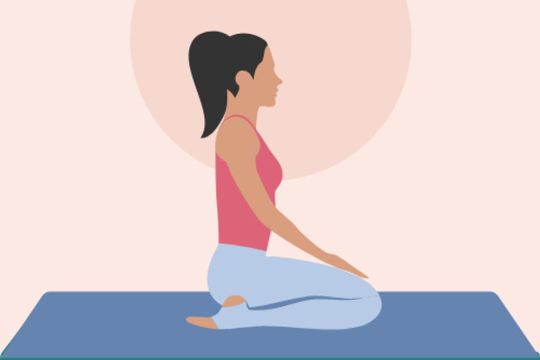
10 Benefits of Yoga
It is a universal truth that the modern age is the age of stress, tension, and anxiety. Nowadays, most of the people have not been leading happy and fruitful life. For such people, money is mother, money is father and money is God. In fact, money is everything for them. These people have excessive money in stores, even then they are mentally disturbed. They can’t sleep without sleeping pills. Kin Hubbard has rightly said, “It is pretty hard to tell what brings happiness: poverty and wealth have both failed.” Everybody is in hurry.
Human beings have no time to think about vacation. He attends parties and takes drinks for relief, satisfaction, and relaxation, but instead of getting peace and relaxation, he comes with more tension, stress, and fatigue. Purchased relaxation does not provide him peace and satisfaction in real life. These problems are affecting such people physically, mentally, and emotionally. That is why they need to learn about 10 benefits of yoga and such people are falling hunt to various diseases.
At this moment, yoga can be very significant for us. We can get rid of such problems by practicing yoga. The following points clearly show the importance of yoga:
1. Physical Purity
Internal organs of our body can be cleaned by various yogic exercises. Basically, there are three substances in our body, i.e., vaat, pitt, and kaph. If there is a proper balance of these substances in our bodies, we may remain healthy. Neti, Dhoti, Nauli, Basti, Kapalabhati, Tratak, etc. are such yogic exercises that keep the internal organs of our body in a clean state. For the proper cleanliness and purity of our internal organs, we should perform these yogic exercises regularly.
2. Cure and prevention from Diseases
There are various diseases that usually hamper the smooth functioning of the body. Various yogic exercises increase the immunity power of an individual. If an individual performs yogic exercises regularly, he cannot fall hunt to diseases.
Vajrasana cures diabetes. A large number of diseases such as bronchitis, arthritis, gastritis, asthma, high blood pressure, hay fever, heart attack, stress, urinary disorders, back pain, etc. can be prevented as well as cured by various yogic exercises.
Also read :- What is the best weight loss diet?
3. Reduces Mental Tension
Yoga can help in reducing the tension. It is a well-known fact that most of the persons remain under stress and tension. They do not get peace anywhere. They think that money can bring happiness and peace to their life but it further intensifies their stress and tension. Pratyahar, Dharana, and Dhyan play a vital role in getting peace of mind. Makarasana, Shavasana, Shalabhasana, Suptasana and Bhujangasana are beneficial for releasing stress and tension.
4. Beautification of Body
Everyone in this world wants to have a beautiful body because it is appreciated by everyone and in every society. Nowadays obesity is common. Everybody wants to be slim, because overweight people do not feel comfortable in any society. Various yogic asanas are the best to get rid of this problem. Yogasanas make the body strong and perfect.
Mayurasanas are helpful for facial beauty. Through yogic exercises face becomes so beautiful that one does not require facial creams. In fact, yoga brightens the face.
5. Provide Relaxation
Rest and relaxation are essential for removing fatigue. When we fall into any physical or mental work, after some time we feel fatigue. At this time, we cannot do further work. So, we need relaxation.
Shavasana and Makarasana are really very beneficial for relaxation. Padmasana and Nadam Sadhana are the best means of reducing mental fatigue.
Also read :- Meaning of yoga
6. Keeps the Correct Posture of Body
Nowadays postural deformities are common in individuals Without good posture they are unable to do their work efficiently. They cannot enjoy life. They usually put more energy into simple tasks. If we perform yogic asanas regularly, we can keep the correct posture of our body.
For example vajrasana, Srvangasana, Mayurasana, Chakrasana, etc. Through these yogic exercises, we can keep our bodies in high spirits.
7. Yoga can be Performed Easily
In present-day life, everybody seems to be in hurry. Life has become fast. Every individual complains of shortage of time. To do exercise, other than yogic exercise requires enough time and money whereas, yogic exercises can be performed easily.
However these exercises can be done in a short duration and are not expensive. Moreover, these exercises can be performed in less space.
8. Increase Flexibility
Flexibility is very valuable for every person. But it makes the movements of the body efficient and graceful. It is also helpful in preventing sports injuries.
Various yogasanas increase the flexibility of the body. Chakrasana, Dhanurasana, Halasana, Bhujangasana are beneficial for increasing flexibility. Muscles also become flexible by performing these asanas.
Also read :-Importance of healthy lifestyle
9. Reduces Obesity
Obesity is a worldwide problem. Obese people fall prey to various diseases. In other words yogic exercises can help in reducing obesity. For example, Pranayama and yogic asanas especially meditative asanas reduce obesity.
Research studies have shown that obesity is also caused by mental tension and stress. So, by reducing mental tension through meditative asanas obesity can be reduced.
10. Improves Health
Yoga helps in maintaining and improving health by making our muscles strong and regulating other systems of the body such as the respiratory, circulatory, nervous, and glandular systems. In other words it increases the efficiency of these systems in our body and thus improves health.
#yoga#yogalove#motivateyourself#motivatingwords#important#of#benefits#fitness#health#healthylifestyle
1 note
·
View note